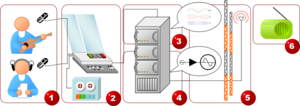-

- Image via Wikipedia
It didn’t take long for people to appreciate the value of broadcasting communications. Listeners could hear the latest news much faster than anywhere else at the time. This value, of course, wasn’t lost on businesses looking for new ways to reach out to more customers. In 1920, the very first commercial broadcast was aired, opening the door to a whole new revolution of advertising.
However, it wasn’t only businesses looking to turn a profit. The stations themselves were searching for new ways to fund their operations, which were starting to run longer, leading to the 24 hour broadcasting heard today. It’s debatable when the first paid radio commercial was aired. Some say it was on WEAF in New York in 1922, while others believe smaller stations and businesses were doing it before then. What isn’t debatable is the reaction that followed. Around this time, programs started mentioning sponsors that would underwrite each show.
As broadcast radio began to enter the Golden Age, so did the radio advertisements. Commercial broadcasts started to try and stimulate more senses than just hearing. Well-known actors began to make appearances while radio ads featured sound effects for greater impact. Radio commercials also started implementing catchy jingles, gaining even greater reach into the conscious of consumers.
Today, it is still very much the same. You can hear a radio spot for Coke during a commercial break or hear that 21st Century Insurance is a sponsor for your favorite show. This is because broadcast radio is still a boon for advertisers. Even though many other media outlets have started attracting consumers online, a whopping 95 percent of people in the U.S. continue to listen to the radio. In addition, over 90 percent of listeners stay tuned even during commercial breaks, unlike television viewers or Internet browsers. So when you next listen to the radio, think about how much hasn’t changed.